Lecture 5: Visionaries: Consciousness Evolution
Adam Blatner
The first lecture, introduced the idea of visionary and the different types, considering the paradigm shifts happening today.
The second lecture explored new dimensions of philosophy.
The third lecture addressed visionaries in psychology.
The fourth lecture presented visionaries in the arena of education and creativity.
This is the fifth lecture and will consider the evolution of consciousness. (Here is the link to a related lecture on "The Great Story, about cosmic evolution, presented in June 2009)
The sixth lecture considers the essential unity of all faiths and the underlying dynamics of spirituality and religion. (This also speaks to the lecture series on "interspirituality" given for the Senior University in the Spring of 2009.)
Evolution
Originally, the term applied to biology, a historical-genetic approach. Gradually, people began to realize that many things had not just risen and fallen without much change in the status of what was involved---the rise and fall of dynasties and even empires, maybe even the birth and death of stars, but that with the birth of more and more interstellar material that included heavier elements, with the emergence of life, something new has happened. Far more complexity has emerged from relative simplicity, and this applies not just to biological systems, but stellar systems, ecosystems, and all streams within the ever-accelerating history of consciousness! |
Consciousness has been evolving with the history of writing and other inventions, and the question now is whether we can become explicitly aware of this process and, based on this growing awareness of its many facets, begin to exercise increasing influence so that we evolve wisely instead of stupidly and self-destructively. The truth is that it's all so complicated that we cannot know for sure, know comprehensively, and use this knowledge to control. There's a fair chance our species has become more cancer-like and will end up generating its own extinction, along with a goodly amount of life on this planet---as hinted out in the movie Wall-E. (Disney-Pixar, 2008, computer-graphic-animated). To the right is a picture of the human becoming more conscious, lighting up the "chakra" centers of awareness.
 |
One of my points is that genes, culture, and technology co-evolve and potentials are released in the mind that may not have been active before. (See a picture on the left.) A related point was made by Marshall McLuhan, an academic who published the book Understanding Media in 1964 (picture below right) (This and related books were quite widely read among intellectuals over the next ten years---his point essentially being that each medium has its own
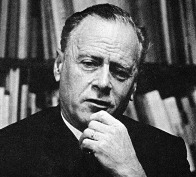 |
Teilhard de Chardin
 |
This Jesuit
paleontologist had a quasi-mystical insight that rather then evolution,
rather than being opposed to religion, was indeed how creation
happened. I mentioned this in the second lecture. and it is relevant
again here. Teilhard coined the term "theosphere" to describe the
growing realm of reflections about our metaphysical origins, and his
point is that just as it was natural for the earth to give birth to
life (the geosphere generating the biosphere), so too the biosphere
will give birth to a noosphere, a category that includes all forms of
sentience and interconnectedness, from bird-brains and bird-calls to
human thought and cell-phones.
But, also, even as it is
natural for the universe to become complex in new ways, so one of those
types of complexity is the emergence of the intuition of a "pattern
that connects," a "wholeness," the concepts of gods and a universal
spirit that integrates all the other spirits---i.e., the noosphere
gives birth to a theosphere. In this sese, we are all participating in
the evolution of and movement towards what Teilhard called the "Christ"
of the cosmos---which, for him, was exemplified in the person of Jesus,
as Teilhard was, after all, a Jesuit. But Teilhard was really talking
about the movement potentially emerging in every soul towards higher
consciousness.
A Map of Emergence of the Noosphere
Below is a picture that suggests the way the noosphere emerges from the biosphere, and that from the geosphere. Note the peculiar shape of widening cone. That means that as time passes the sphere expands exponentially. And more and more sub-types appear---that's what it means by "variance."
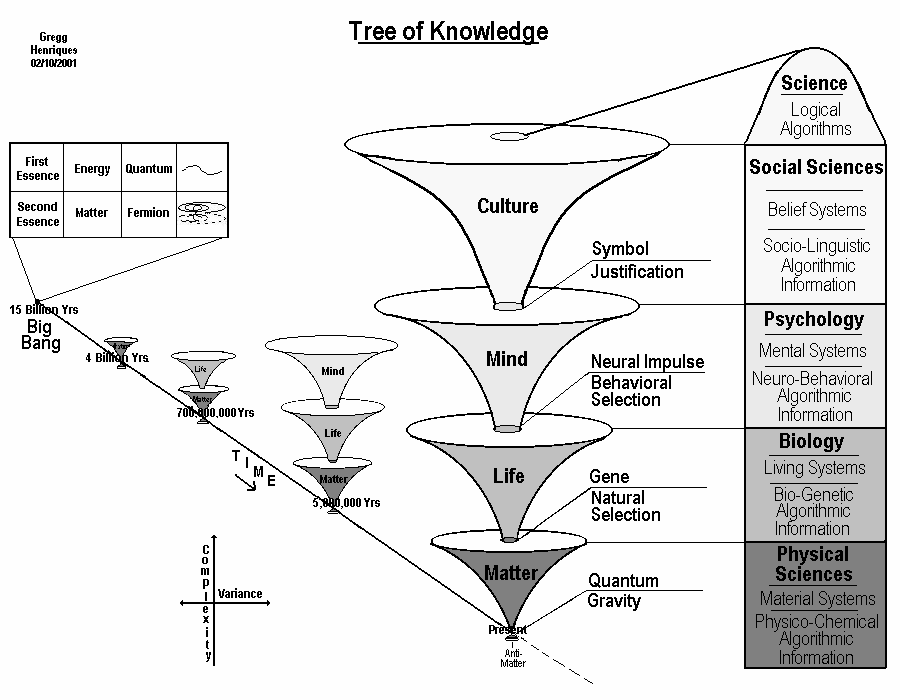 |
I would suggest that we
also dare add another cone of wisdom sprouting out of the the culture:
Theosphere? Or is this a synthesis (as I think it should be) among
psychology, philosophy (belief systems), and perspectives that attempt
to penetrate the limitations of left-brain consciousness, that resonate
with myth-making, that balance critical thinking with imaginativeness,
creativity, and empathy! And some myth-making may be part of all this,
a myth that goes beyond the traditional notions of theism? (But this
then reaches into the topic of the next lecture, inter-spirituality.)
 |
The Exponential Curve
It isn't just a matter
of a linear slope upwards, X this year, X+20% next year, and that
product + 20% the year after---that's a linear acceleration..An
exponential curve doubles and re-doubles, and that's what has been
happening with population every generation, or with information
transmission every few years, or with information available on Google
or to librarians, or many other variables. That's the time we're in---a
time when the slope of progress isn't a straight line up, but a curved
line, like the one on the right.
The point here is that
many variables that accompany our transition from agrarian to
industrial to modern to post-modern culture follow this curve. We're on
a steeply rising acceleration of events, and we need to develop
philosophies and theologies that take these changes into account. They
are not necessarily positive---our rates of extinction of animals and
pollution also follow such curves.
The "Anthropocene" Era
This is a term recently
coined to speak to a historical time when the human species shifts from
riding in and on the biosphere to increasingly altering it---generally
not for the better---and so the era of "dominion" of humanity needs to
shift from exploitation to husbanding, protecting, sustaining the
biosphere. Will we be able to learn the skills, and shift the economic
and political systems to allow us to survive? This picture below
is from The Economist, May 28, 2011.
We are here at the last part of the bottom right.
Yikes!
What Should Be Recognized as Steps in the Evolution of Consciousness?
To the right: Was fire a step towards consciousness? Fire not only is used for warmth and for cooking, but spears can be hardened by toasting them but not burning them in the fire.
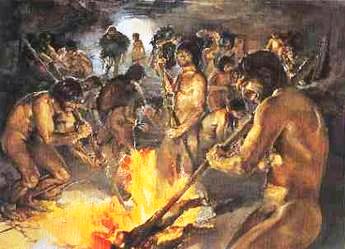 |
Writing: Another Step
Last year I gave a class on "scriptology: the lore of writing systems. I confess that I think the invention of ways to take thoughts and place them were they can be re-viewed, literally, made thinking more complex.36. What do you think would or should count as a step in the evolution of consciousness?
How about these?
- The invention of writing, fire, wheel, domestication of animals, agriculture
- The development of the scientific method in the 17th century, and many kinds of research. Really questioning what others just believe.
- .Challenging traditions of kingship, aristocracy, slavery, and many other oppressions.
- Beginning to value creativity over mindless obedience
- Beginning to think about the way we think---"meta-cognition," and look at the ways we fool ourselves, interpersonal manipulations, cultural deceptions.
Or how about the following: Would they count as steps in the evolution of consciousness?
- Substituting lure-based rather than fear -based motivational systems in politics, religion, parenting, schools and businesses
- Religion shifts its emphasis on ensuring orthodoxy on what people believe and instead emphasize helping people to find out for themselves what lifts them, ennobles them, helps them feel more connected
- People truly realizing that advances require trade-offs, especially getting past illusions of childhood
... what steps would you imagine? I'm open to your emailing me with suggestsions.
Overlapping Domains
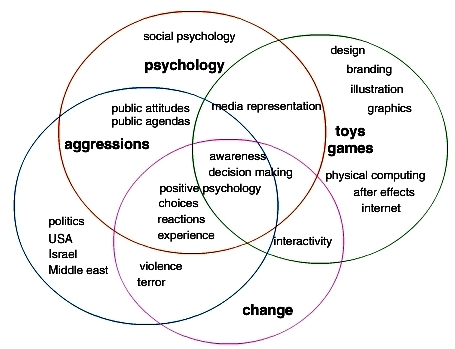 |
For the reasons on the right---which is only a small part of what is up---I can relate to, say, positive psychology, discussed in the second lecture, and so forth.
Turning It Around
 |
A related book titled The Empathic Civilization by Jeremy Rifkin, makes a lengthy and elegant case for how people can move toward the next step.. A point to note is that this kind of activity will not be done for us by an omnipotent God, but rather requires us to work on our changing our own consciousness---and this starts with noticing how you think, how often you slip, and not blaming or punishing yourself, but just
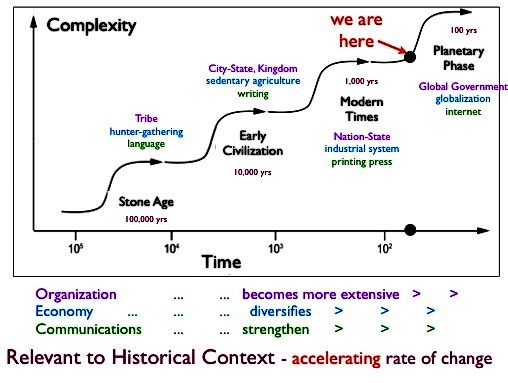 |
Regarding the chart to the right, I know the idea of globalization is politically problematical, but note that there are allready a number of global institutions—operating beyond any borders— professional, religious, non-governmental aid organizations, research, health, and so forth, in addition to numerous efforts by one country or group of countries to foster peacemaking or conflict resolution beyond their own borders. (Note the ordinate or horizontal line is decreasing exponentially.. Meaning that all this is getting faster)....
Summary
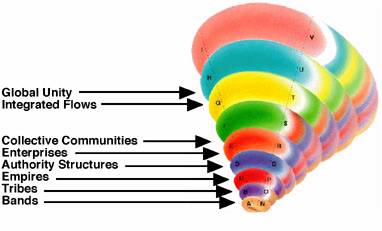 |
 |
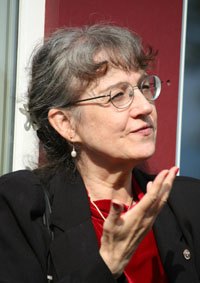 |
44. Here’s a lady who has made good contributions to this and the point in this chart is the general numbers of the population, which I wouldn’t disagree with except to say that in the last generation maybe the upper numbers have gone up proportionally a little bit... I do think we’re advancing...
Most folks live at the level of early industrialization and literacy and in the blue realm, some in the orange or modern, a modest percentage of college/psychology types more 4-5, and most visionaries here with vision...
So, Let's aim for the best! Next time we'll talk about interspirituality
email to me at adam@blatner.com.